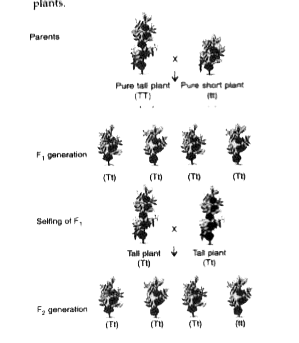In one of his experiments with pea plants Mendel observed that when a pure tall pea plant is crossed with a pure dwarf pea plant, in the first generation, F1 only tall plants appeared.
(i) What happens to the traits of the dwarf plants in this case?
(ii) When the F1 generation plants were self-fertilised, he observed that in the plants of second generation, F2 both tall plants and dwarf plants were present. Why it happened? Explain briefly.Solution in Kannada
(a) Mendel crossed tall pea plants with dwarf pea plants.

Mendel.s Observation
The F1 generation contained all tall plants. When F1 generation underwent selfing, the trait that was unexpressed in F1 (dwarf) was observed in some F2 progeny. Thus, both traits, tall and dwarf, were expressed in F2 generation in the ratio 3: 1.
Mendel proposed that something was being passed unchanged from generation to generation. He called these things factors (presently called genes). Factors contain and carry hereditary information. He also observed that traits might not show up in an individual but were passed to the next generation.
(b) The two contrasting traits other than height used by Mendel are :
(i) Pod colour : Green pod colour dominant over yellow colour
(ii) Seed shape : Round seed shape dominant over wrinkled seed shape.
Topper's Solved these Questions
- HEREDITY AND EVOLUTIONBook:OSWAAL PUBLICATIONChapter:HEREDITY AND EVOLUTIONExercise:TOPIC - 1 (HEREDITY AND MENDEL.S CONTRIBUTION)(LONG ANSWER TYPE QUESTIONS)
Explore 6 Videos
- HEREDITY AND EVOLUTIONBook:OSWAAL PUBLICATIONChapter:HEREDITY AND EVOLUTIONExercise:TOPIC - 2 (ORIGIN OF LIFE AND EVOLUTION)(MULTIPLE CHOICE QUESTION)
Explore 1 Video
- HEREDITY AND EVOLUTIONBook:OSWAAL PUBLICATIONChapter:HEREDITY AND EVOLUTIONExercise:TOPIC - 1 (HEREDITY AND MENDEL.S CONTRIBUTION)(SHORT ANSWER TYPE QUESTIONS - I)
Explore 10 Videos
- CONTROL AND CO-ORDINATIONBook:OSWAAL PUBLICATIONChapter:CONTROL AND CO-ORDINATIONExercise:NCERT CORNER (Textbook Exercises)
Explore 12 Videos
- HOW DO ORGANISMS REPRODUCE?Book:OSWAAL PUBLICATIONChapter:HOW DO ORGANISMS REPRODUCE?Exercise:NCERT CORNER (TEXTBOOK EXERCISES)
Explore 11 Videos
Similar Questions
(a) Why did Mendel choose garden pea for his experiments? Write two reasons.
(b) List two contrasting visible characters of garden pea Mendel used for his experiment.
(c) Explain in brief how Mendel interpreted his results to show that the traits may be dominant or recessive.
View SolutionIdentify the correct pair of analogous organ from the following:
View SolutionWhat are characteristics? Give an example.
View SolutionWhich of the following is a plant hormone ?
View SolutionAsexual reproduction takes place through budding in
View SolutionPure tall plant is crossed to dwarf plant. F1 generation consists of only tall plants while F2 generation has both tall and dwarf in ratio of 3:1. The phenomenon is due to
View SolutionA tall pea plant with round seeds (TTRR) is crossed with a dwarf wrinkle seeded plant (ttrr). F1 has tall plants with rounded seeds. What is the proportion of dwarf plants with wrinkled seeds in F2 generation
View SolutionPure-bred tall pea plants are first crossed with pure-bred dwarf pea plants. The pea plants obtained in F_(1) generation are then cross-bred to produce F_(2) generation of pea plants. (i) What do the plants of F_(1) generation look like ? (b) What is the ratio of all plants to dwarf plants in F_(2) generation ? (c) Which type of plants were missing in F_(1) generation but reappeared in F_(2) generation ?
View SolutionPure tall plants are crossed with pure dwarf plants. In the F1 generation, all plants were tall. These tall plants of F1 generation were selfed and the ratio of tall to dwarf plants obtained was 3:1. This is called
View SolutionPure-bred tall pea plants are first crossed with pure-bred dwarf pea plants. The pea plants obtained in F1 generation are then cross-bred to produce F2 generation of pea plants.
(a) What do the plants of F1 generation look like?
(b) What is the ratio of tall plants to dwarf plants in F2 generation?
(c ) Which type pf plants were missing in F1 generation but reappeared in F2 generation?
View SolutionGive the genotypic and phenotypic ratio of F_(1) , generation,when a hybrid tall (Tt) pea plant is crossed with a pure dwarf (tt)pea plant.
View SolutionIn one of his experiments with pea plants Mendel observed that when a pure tall pea plant is crossed with a pure dwarf pea plant, in the first generation, F1 only tall plants appear.
(a) What happens to the traits of the dwarf plants in this case?
(b) When the F1 generation plants were self-fertilised, he observed that in the plants of second generation, F2 both tall plants and dwarf plants were present. Why it happened? Explain briefly.
View SolutionIf we cross-bred tall (dominant) pea plant with pure-bred dwarf (recessive) pea plant, we will get plants of F1 generation. If we now self-cross the pea plant of F1 generation, we obtain pea plants of F2 generation. State the ratio of tall plants to dwarf plants in F2 generation.
View SolutionIn one of his experiments with pea plants Mendel observed that when a pure tall pea plant is crossed with a pure dwarf pea plant, in the first generation, F1 only tall plants appeared.
(i) What happens to the traits of the dwarf plants in this case?
(ii) When the F1 generation plants were self-fertilised, he observed that in the plants of second generation, F2 both tall plants and dwarf plants were present. Why it happened? Explain briefly.
View SolutionDwarf pea was treated with gibberellic acid. It became as tall pea plants. If these pea plants are crossed with pure tall plants. What will be the phenotype ratio in F2 generation?
View SolutionA true breeding tall pea plant crossed with the true breeding drawf plant gave F1 selfing resulted in 787 tall and 277 dwarf plants in F2 generation. The F1 plants are
View Solution

